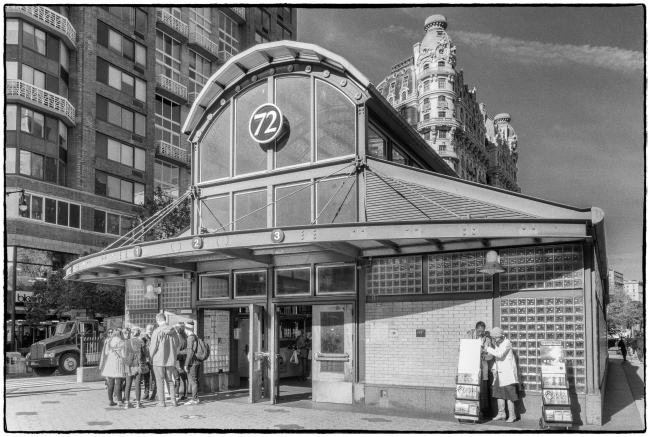A different kind of New York City subway station.
According to Wikipedia:
The 72nd Street station opened on October 27, 1904, as part of the original subway, with trains running from Brooklyn Bridge to 145th Street. The original configuration of the station was inadequate by IRT standards. It had just one entrance (the control house on the traffic island between 71st and 72nd Streets, now listed on the National Register of Historic Places), and the platforms and stairways were unusually narrow. There were no crossovers or crossunders as the control house had separate turnstile banks and token booths for each side. Express trains ran on the innermost two tracks, while local trains ran on the outer pair.
During the 1950s, the New York City Transit Authority (now the Metropolitan Transportation Authority, or MTA) considered converting the station to a local station by walling off the express tracks from the platforms. This would have coincided with 59th Street–Columbus Circle, which is a major transfer point to the IND Eighth Avenue Line, becoming an express stop.
A substantial renovation was completed on October 29, 2002, providing a new, larger control house on the traffic island between 72nd and 73rd Streets and slightly wider platforms at the north end of the station. This control house has two staircases and one elevator from each platform going up to a crossover, where on either side a turnstile bank leads to either 72nd or 73rd Streets. Only the southern turnstile bank has a staffed token booth and the elevators make this station ADA-accessible. This control house has an artwork, Laced Canopy by Robert Hickman, which consists of a mosaic pattern on the central skylight; if looked at in the right way, the knots within the pattern make up the notation for an excerpt of Verdi’s Rigoletto. The original control house was renovated and now has a total of five staircases: two to the southbound platform and three to the northbound platform. These staircases go up to a crossover, where on the north side, an unstaffed turnstile bank leads to 72nd Street and on the south side, three High Entry/Exit Turnstiles lead to 71st Street. This control house has artful wrought iron pillars, dating back to the days of the original subway system, as well as decorated ceiling beams.
The is the new control house. The old control house is across the street.

